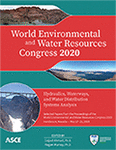World Environmental and Water Resources Congress 2020
An Overview of the Transient Simulation in Water Distribution Networks (TSNet)
Publication: World Environmental and Water Resources Congress 2020: Hydraulics, Waterways, and Water Distribution Systems Analysis
ABSTRACT
In water distribution networks (WDNs), hydraulic transients reveal information about the state of the WDN and its responses to operational changes in valves and pumps as well as pipe leaks and bursts. Thus, transient simulation, as a conventional approach to model and predict these transient behaviors, has shown increasing promises in various applications, such as WDN design, fault detection, sensor placement, and risk assessment. To facilitate the integration of transient simulation in these case-specific applications, this work contributes the transient simulation in water networks (TSNet), a new open-source Python package. TSNet includes the capacities to: (1) read EPANET INP files, (2) establish initial conditions, (3) perform transient simulations in various conditions, including valve and pump operations, leaks, and bursts, and (4) obtain and visualize results. TSNet not only provides users with a freely accessible software, rendering easiness for interaction, but also presents a platform where users and developers can further develop, improve, and extend the existing transient model. This paper includes the discussion on TSNet modeling framework, capabilities, an example application, and resources to help users to familiarize and interact with TSNet. TSNet can be downloaded from the GitHub repository, and the package documentation is available from Read the Docs. The GitHub repository contains links to software documentation, example codes and networks, and contacting information for reporting bugs and questions.
Get full access to this article
View all available purchase options and get full access to this chapter.
REFERENCES
Boulos, P. F., Karney, B. W., Wood, D. J., and Lingireddy, S. (2005). “Hydraulic transient guidelines for protecting water distribution systems.” Journal / American Water Works Association, 97(5), 111–124.
Capponi, C., Ferrante, M., Zecchin, A. C., and Gong, J. (2017). “Leak detection in a branched system by inverse transient analysis with the admittance matrix method.” Water Resources Management, Springer, 31(13), 4075–4089.
Gong, J., Simpson, A. R., Lambert, M. F., Zecchin, A. C., Kim, Y. il, and Tijsseling, A. S. (2013). “Detection of distributed deterioration in single pipes using transient reflections.” Journal of Pipeline Systems Engineering and Practice.
HAMMER, Bentley. (2019). “Water Hammer and Transient Analysos Software.”
Innovyze. (2019). “InfoSurge - User Giude.”
Karim, M. R., Abbaszadegan, M., and Lechevallier, M. (2003). “Potential for pathogen intrusion during pressure transients.” Journal / American Water Works Association, 95(5), 134–146.
Kleiner, Y., and Rajani, B. (2001). “Comprehensive review of structural deterioration of water mains: Statistical models.” Urban Water.
Klise, K. A., Murray, R., and Haxton, T. (2018). “An Overview of the Water Network Tool for Resilience (WNTR).” WDSA / CCWI Joint Conference Proceedings.
KyPipe, LLC. (2019). “Pipe 2018 Users Guide.”
Liggett, J. A., and Chen, L. C. (1994). “Inverse transient analysis in pipe networks.” Journal of Hydraulic Engineering.
McInnis, D. A., Karney, B. W., and Axworthy, D. H. (1998). “TransAM reference manual.” HydraTek Associates, Toronto, Ont.
Rajani, B., and Kleiner, Y. (2001). “Comprehensive review of structural deterioration of water mains: Physically based models.” Urban Water.
Rezaei, H., Ryan, B., and Stoianov, I. (2015). “Pipe failure analysis and impact of dynamic hydraulic conditions in water supply networks.” Procedia Engineering, Elsevier, 119, 253–262.
Rossman, L. A. (2000). EPANET 2 User Manual. Social Studies of Science.
Vicente, D. J., Garrote, L., Sánchez, R., and Santillán, D. (2016). “Pressure Management in Water Distribution Systems : Current Status, Proposals, and Future Trends.” Journal of Water Resources Planning and Management, 142(2), 1–13.
Wang, R., Wang, Z., Wang, X., Yang, H., and Sun, J. (2014). “Pipe Burst Risk State Assessment and Classification Based on Water Hammer Analysis for Water Supply Networks.” 140(6), 1–8.
Wang, X. J., Lambert, M. F., Simpson, A. R., Liggett, J. A., and Vítkovský, J. P. (2002). “Leak detection in pipelines using the damping of fluid transients.” Journal of Hydraulic Engineering.
Wood, D. J., Lingireddy, S., Boulos, P. F., Karney, B. W., and McPherson, D. L. (2005). “Numerical methods for modeling transient flow in distribution systems.” Journal AWWA, 97(July), 104–115.
Wylie, E. B., and Streeter, V. L. (1993). “Fluid Transients in Systems.” PrenticeHall Upper SaddleRiver NJ.
Xing, L., and Sela, L. (2019). “Unsteady pressure patterns discovery from high-frequency sensing in water distribution systems.” Water Research.
Xu, X., and Karney, B. (2017). “An Overview of Transient Fault Detection Techniques.” Modeling and Monitoring of Pipelines and Networks, 13–37.
Information & Authors
Information
Published In
World Environmental and Water Resources Congress 2020: Hydraulics, Waterways, and Water Distribution Systems Analysis
Pages: 282 - 289
Editors: Sajjad Ahmad, Ph.D., and Regan Murray, Ph.D.
ISBN (Online): 978-0-7844-8297-1
Copyright
© 2020 American Society of Civil Engineers.
History
Published online: May 14, 2020
Published in print: May 14, 2020
Authors
Metrics & Citations
Metrics
Citations
Download citation
If you have the appropriate software installed, you can download article citation data to the citation manager of your choice. Simply select your manager software from the list below and click Download.
